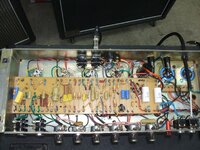1975 Superlead should be the following specs. 820/330uf V1A, 2.7K/.68uf V1B, 820/.68uf V2A, NFB should be a 100K resistor on the 4 ohm tap. Sometimes Marshall left the .68uf off of V2A and sometimes used 1K V2A cathode resistors instead of 820. My 72 SL has a 1K instead of an 820 ohm on V2A but it did have the .68uf cathode Mustard bypass cap stock. Alot of amps seem to hit or miss in this era whether or not they got the .68uf for V2A.
From 72 onward Marshall was still using up some RS/Lemco 500/560pf mica caps on the 470k/470K mixer and the tonestack which is more plexi. My 72 had standard brown ceramic 500pf cap on the 470K/470K mixer, a 5000pf Lemco bright cap, 560pf RS Mica cap on the tonestack and 100K NFB resistor on the 4 ohm tap.
Also starting in 69/70 amps could also get the red tubular ceramic dogbone caps, as well as the mica, or small round ceramic disc cap in the mixer and tonestack locations, it just depended on what parts Marshall had when your amp got built really.
As these small brown ceramic disc caps age they can get kinda harsh sounding, my 72 was pretty strident in the highs, super aggressive and harsh which I didn't care for so when I recapped the entire amp , V1A, 10 uf bias caps 50/50, filter caps a couple of years ago I used the standard 68/69 plexi specs. I removed the small 500pf ceramic disc cap from the 470k/470k mixer and installed an NOS RS 560pf mica cap I still had lying around as my amp already had an RS 560pf mica cap in the tonestack. I also replaced the original Lemco 5000pf cap with a new NOS 5000pf Mallory cap. I did keep the original 100K NFB resistor but I put the NFB on the 8 ohm tap like a plexi. The 100K NFB will make the amp a bit more ratty and just tad looser so if you want the plexi clarity, tightness and headroom you will need to change the 100K to a 47K NFB resistor or piggyback another 100K on top of the existing 100K which will give you 50K NFB and then put the NFB tap on the 8 ohm impedance tap.
I found after I removed the small brown ceramic cap from the 470K/470K mixer and installed the nos rs 560pf mica as well as the old 5000pf lemco the amp got more quiet and less hissy and more in line with my 68 Plexi which I really love, I also replaced the stock V1B .0022uf metal tubular polystyrene coupling cap with an NOS Mustard cap and replaced the power cord and redid the grounding on the plug. I'm running a Lar/Mar PPIMV in place of the presence pot and moved the presence pot down into the empty hole for the polarity switch.
If you like the more ratty, more aggressive less headroom tone and you still feel the amp sounds harsh try replacing the 470K/470K with an NOS CDE silver mica, even the newer CDE's are good and possibly the old Lemco/RS 5000pf bright cap.
I really like the 5000pf bright channel bright cap as it really brings out the amps aggressive crunchy nature that is a Marshall Plexi/Superlead IMHO but some people like the bright cap lowered to 1000pf, 500pf or just removed which make the amp more like a Super Bass, if you like it that all that counts. I also kept the stock 72 filtering across the board as my 72 is a 50 watter it has 50uf/50uf preamp, 100uf mains, 50 screens, 50uf Phase Inverter and it's not that far off of my 68 plexi and the 69 SL I built with 100% NOS parts was all standard 50/50uf SL filtering and that amp kicked all sorts of ass, every bit as good as my 68. For a 69 and up 100 watter it will be 50uf mains, 50uf screens, 50uf/50uf preamp and 100uf Phase Inverter. For a 68 it is 50uf mains, 32uf/32uf in series for16uf screens, 32uf/32uf preamp and either 64uf or 100uf for the phase inverter, I prefer 100uf, less ghosting with 100uf.
Good luck, let us know how the expermientation goes.


